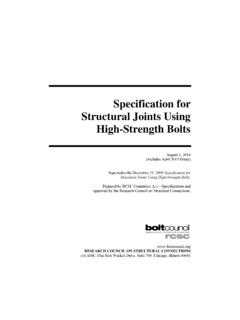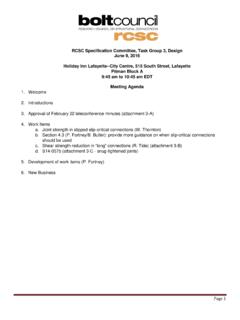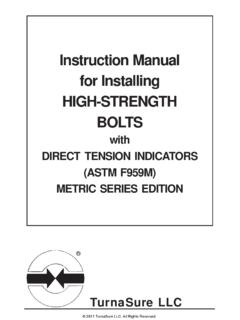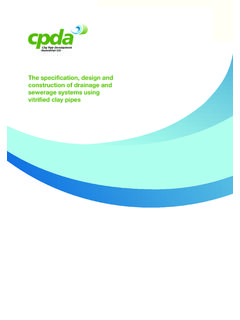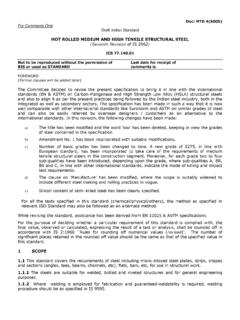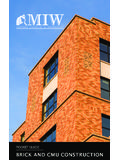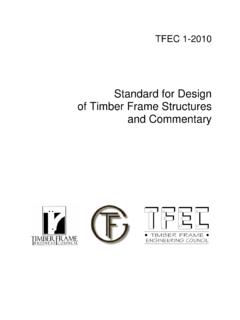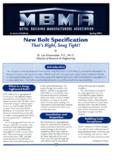Transcription of Specification for Structural Joints Using High …
1 Specification for Structural Joints Using high - strength Bolts December 31, 2009 Supersedes the June 30, 2004 Specification for Structural Joints Using ASTM A325 or A490 Bolts. Prepared by RCSC Committee Specifications and approved by the Research Council on Structural Connections. RESEARCH COUNCIL ON Structural CONNECTIONS c/o AISC, One East Wacker Drive, Suite 700, Chicago, Illinois 60601 Specification for Structural Joints Using high - strength Bolts, December 31, 2009 RESEARCH COUNCIL ON Structural CONNECTIONS RCSC 2010 by Research Council on Structural Connections All rights reserved. This book or any part thereof must not be reproduced in any form without the written permission of the publisher. The information presented in this publication has been prepared in accordance with recognized engineering principles and is for general information only.
2 While it is believed to be accurate, this information should not be used or relied upon for any specific application without competent professional examination and verification of its accuracy, suitability, and applicability by a licensed professional engineer, designer, or architect. The publication of the material contained herein is not intended as a representation or warranty on the part of the Research Council on Structural Connections or of any other person named herein, that this information is suitable for any general or particular use or of freedom from infringement of any patent or patents. Anyone making use of this information assumes all liability arising from such use. Caution must be exercised when relying upon other specifications and codes developed by other bodies and incorporated by reference herein since such material may be modified or amended from time to time subsequent to the printing of this edition.
3 The Institute bears no responsibility for such material other than to refer to it and incorporate it by reference at the time of the initial publication of this edition. Printed in the United States of America Specification for Structural Joints Using high - strength Bolts, December 31, 2009 RESEARCH COUNCIL ON Structural CONNECTIONS PREFACE The purpose of the Research Council on Structural Connections (RCSC) is: (1) To stimulate and support such investigation as may be deemed necessary and valuable to determine the suitability, strength and behavior of various types of Structural connections; (2) To promote the knowledge of economical and efficient practices relating to such Structural connections; and, (3) To prepare and publish related specifications and such other documents as necessary to achieving its purpose.
4 The Council membership consists of qualified Structural engineers from academic and research institutions, practicing design engineers, suppliers and manufacturers of fastener components, fabricators, erectors and code-writing authorities. The first Specification approved by the Council, called the Specification for Assembly of Structural Joints Using high Tensile Steel Bolts, was published in January 1951. Since that time the Council has published sixteen successive editions. Each was developed through the deliberations and approval of the full Council membership and based upon past successful usage, advances in the state of knowledge and changes in engineering design practice. This edition of the Council s Specification for Structural Joints Using high - strength Bolts continues the tradition of earlier editions.
5 The major changes are: ASTM F2280 bolt assemblies were added to the Specification . ASTM F1136 coating usage was added to the Specification . References to ASTM A153 have been replaced with an updated reference to ASTM F2329. Section was modified to provide a clarification on thermally-cut holes. Section was modified in regard to burrs over z in. high . Table was modified to show new shear design values for Joints based on overall joint length. Sections 7 and 8 had a number of clarifications added in relation to pre-installation testing and installation practices. Table was added to clarify the minimum bolt pretension for pre-installation verification. The snug-tight definition and references have been modified to make this terminology less subjective in its application. Appendix B Tables were brought into consistency with equivalent provisions in Section 5.
6 In addition, typographical changes have been made throughout this Specification . Specification for Structural Joints Using high - strength Bolts, December 31, 2009 RESEARCH COUNCIL ON Structural CONNECTIONS By the Research Council on Structural Connections, Charles J. Carter Chairman Gregory S. Miazga Vice Chairman Chad M. Larson Secretary/Treasurer Abolhassan Astaneh-Asl Joseph G. Bahadrian Rodney L. Baxter John J. Biel Peter C. Birkemoe David W. Bogaty Salim V. Brahimi Richard C. Brown Frank Buck Bruce M. Butler Helen H. Chen Robert J. Connor Bastiaan E. Cornelissen Chris Curven Nick E. Deal James M. Doyle Dean G. Droddy Peter Dusicka Douglas B. Ferrell John W. Fisher Patrick J. Fortney Danilo M. Francisco Karl H. Frank Michael C. Friel James B. Gialamas Rodney D. Gibble Michael I. Gilmor Joe Greeenslade Gilbert Y. Grondin Jerome F. Hajjar Allen J. Harrold Robert A.
7 Hay III Ian C. Hodgson Charles E. Hundley Kaushik A. Iyer Emmanuel P. Jefferson Suja G. John Donald L. Johnson Ronald B. Johnson Peter F. Kasper Daniel J. Kaufman James S. Kennedy Lawrence A. Kloiber Richard F. Knoblock Lawrence Kruth Geoffrey L. Kulak Bill R. Lindley, II Kenneth B. Lohr Hussam N. Mahmoud Curtis Mayes Jonathan C. McGormley David L. McKenzie Neil L. McMillan Jinesh K. Mehta William A. Milek, Jr. Eugene R. Mitchell Heath E. Mitchell Scott Munter Thomas M. Murray Gian A. Rassati James M. Ricles Thomas J. Schlafly Gerald E. Schroeder David F. Sharp Robert E. Shaw, Jr. Victor Shneur W. Lee Shoemaker James A. Swanson Arun A. Syam Thomas S. Tarpy, Jr. William A. Thornton Raymond Tide Todd C. Ude Amit H. Varma M. Blane Vines Floyd J. Vissat I. Wayne Wallace Charles J. Wilson Alfred F. Wong Joseph A. Yura Specification for Structural Joints Using high - strength Bolts, December 31, 2009 RESEARCH COUNCIL ON Structural CONNECTIONS TABLE OF CONTENTS Symbols.
8 Vii Glossary .. ix Section 1. General Requirements .. 1 Scope .. 1 Loads, Load Factors and Load Combinations .. 1 Referenced Standards and Specifications .. 2 Drawing Information .. 3 Section 2. Fastener Components .. 5 Manufacturer Certification of Fastener Components .. 5 Storage of Fastener Components .. 5 Heavy-Hex Structural Bolts .. 6 Heavy-Hex Nuts .. 13 Washers .. 14 Washer-Type Indicating Devices .. 14 Twist-Off-Type Tension-Control Bolt Assemblies .. 15 Alternative-Design Fasteners .. 16 Section 3. Bolted Parts .. 17 Connected Plies .. 17 Faying Surfaces .. 17 Bolt Holes .. 21 Burrs .. 24 Section 4. joint Type .. 26 Snug-Tightened Joints .. 28 Pretensioned Joints .. 29 Slip-Critical Joints .. 30 Section 5. Limit States in Bolted Joints .. 31 Design Shear and Tensile strength .
9 32 Combined Shear and Tension .. 35 Design Bearing strength at Bolt Holes .. 36 Design Slip Resistance .. 38 Tensile Fatigue .. 42 Section 6. Use of Washers .. 44 Snug-Tightened Joints .. 44 Pretensioned Joints and Slip-Critical Joints .. 44 Section 7. Pre-Installation Verification .. 47 Tension Calibrator .. 47 Required Testing .. 49 Specification for Structural Joints Using high - strength Bolts, December 31, 2009 RESEARCH COUNCIL ON Structural CONNECTIONS Section 8. Installation .. 51 Snug-Tightened Joints .. 51 Pretensioned Joints and Slip-Critical Joints .. 51 Section 9. Inspection .. 59 Snug-Tightened Joints .. 59 Pretensioned Joints .. 59 Slip-Critical Joints .. 62 Section 10. Arbitration .. 63 Appendix A. Testing Method to Determine the Slip Coefficient for Coatings Used in Bolted Joints .
10 65 A1. General Provisions .. 65 A2. Test Plates and Coating of the Specimens .. 66 A3. Slip Tests .. 69 A4. Tension Creep Tests .. 73 Appendix B. Allowable Stress Design (ASD) Alternative .. 75 References .. 80 82 Specification for Structural Joints Using high - strength Bolts, December 31, 2009 RESEARCH COUNCIL ON Structural CONNECTIONS SYMBOLS The following symbols are used in this Specification . Ab Cross-sectional area based upon the nominal diameter of bolt, D Slip probability factor as described in Section Du Multiplier that reflects the ratio of the mean installed bolt pretension to the specified minimum bolt pretension, Tm, as described in Section Fn Nominal strength (per unit area), ksi Fu Specified minimum tensile strength (per unit area), ksi I Moment of inertia of the built-up member about the axis of buckling (see the Commentary to Section ), L Total length of the built-up member (see the Commentary to Section ), in.
